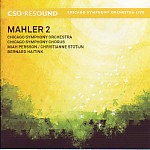The Chicago Symphony Orchestra probably can play this symphony by heart, and certainly its fabled brass (particularly trombones and horns), as well as the superb chorus, give the big moments the weight that they require. The problem is that the rest of the orchestra–not to mention Bernard Haitink–seems not to be making a similar effort. As an interpreter, Haitink remains a cypher. This is at least his fourth authorized recording of this symphony, and while it’s not quite as dull as his Berlin remake for Philips, it contains neither a single distinctive interpretive idea nor an atom of passion.
While up to tempo, there’s no sense of struggle in the first movement, no menace in its coda, no quirky humor in the scherzo, and the finale lacks any sense of urgency–it particularly hangs fire as soon as the chorus enters. The “cry of despair” in the third movement is impressive because the orchestra knows how it goes, not because Haitink takes any trouble to make something special of it. Similarly the final chorale has impact because the chorus sings wonderfully, and the organ pedals are well caught by the otherwise low-level recording.
But where is the bite to the cellos and basses at the symphony’s opening, the vigor in the finale’s “dead march”, or the transcendent power of the final pages (almost no bells, by the way)? It’s Haitink on autopilot, as he so often seems to be these days. Among the soloists Christianne Stotijn turns in a lovely “Urlicht”, but Miah Persson’s voice lacks the necessary purity to float over the choir in her first two entrances in the finale.
This is nothing more than a respectable, workaday subscription performance that any paying concertgoer surely would have enjoyed, but it has no business being preserved and issued on disc. Haitink’s finest “Resurrection” by far remains his first, more as a classic example of a great Mahler orchestra’s characteristic style in the 1960s than for anything he brings to the party. His later performances prove convincingly that most of the credit for the excellence of that first version does not rest with the conductor. There is something to be said for his naturally self-effacing approach, his willingness to let the music “speak for itself”–but then, why keep recording it over and over? Enough already.
































